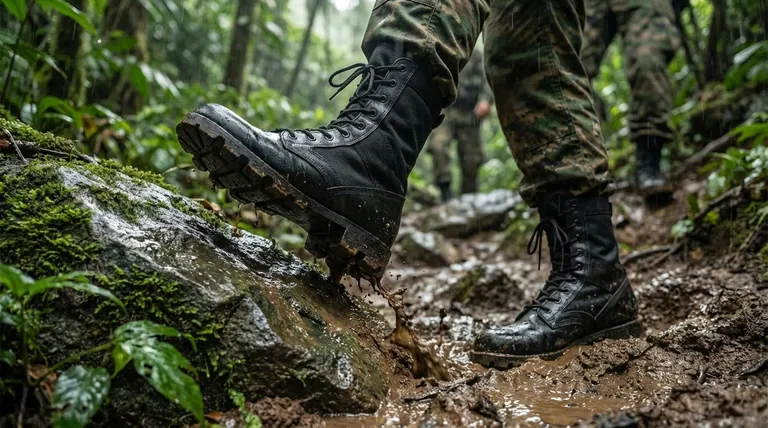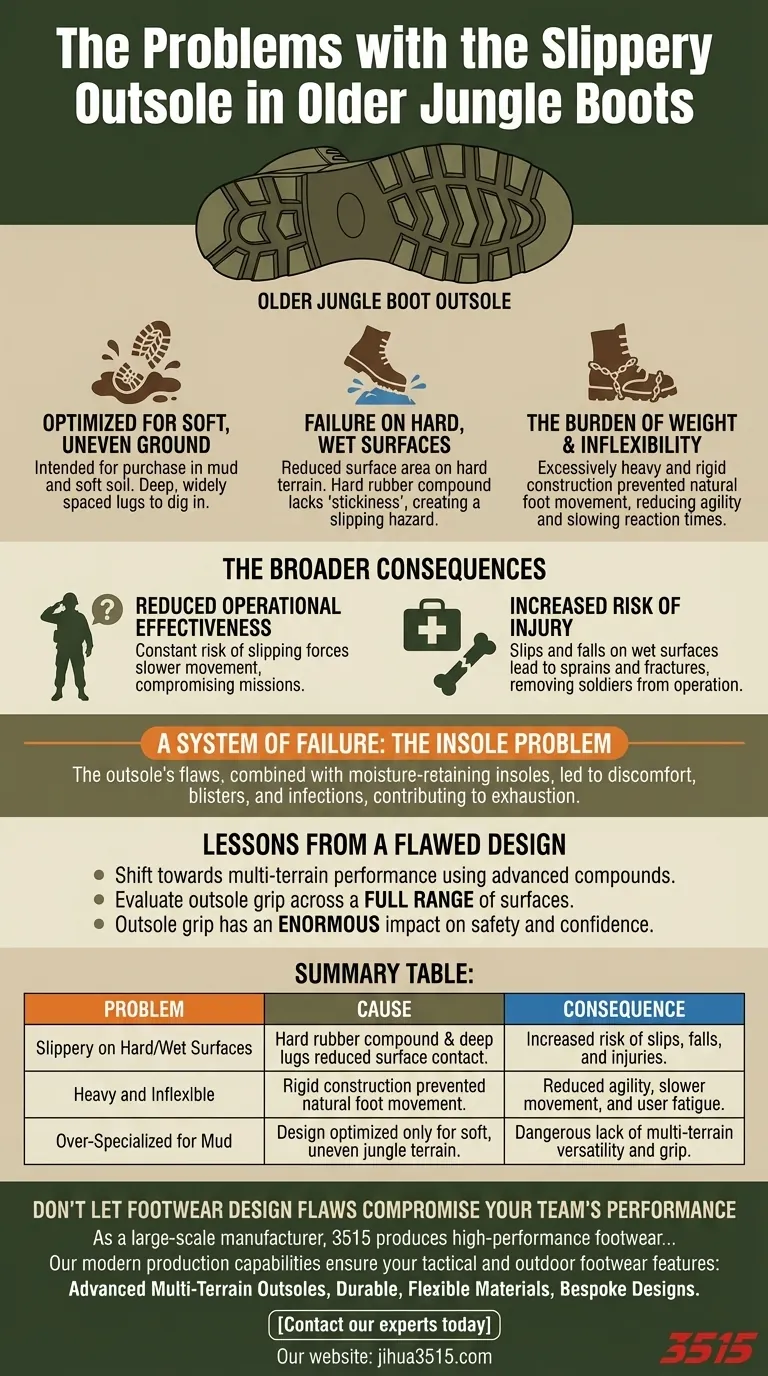The primary problem with the outsole of older jungle boots was a design optimized exclusively for uneven, soft terrain, which made it dangerously ineffective on other common surfaces. Its hard, inflexible rubber and deep lug pattern lacked the necessary grip on anything smooth or wet, creating a significant and constant slipping hazard for the wearer.
The older jungle boot's outsole represents a critical lesson in over-specialization. By focusing so heavily on performance in mud, its design created a heavy, inflexible, and dangerously slippery boot on the very surfaces—like wet rocks, logs, or man-made structures—that soldiers frequently encountered.

The Core Design Flaw: A Mismatch of Material and Mission
The issues with the jungle boot's outsole were not accidental; they were the direct result of a design philosophy that prioritized one specific function above all others.
Optimized for Soft, Uneven Ground
The original design was intended to give soldiers purchase in the mud and soft soil of a jungle floor. Its deep, widely spaced lugs were meant to dig in and provide traction, much like a tractor tire.
Failure on Hard, Wet Surfaces
This specialization was its downfall. On hard surfaces like rock, packed earth, or concrete, the deep lugs reduced the amount of surface area in contact with the ground. The hard rubber compound was not "sticky" and could not conform to micro-irregularities, making it extremely slippery when wet.
The Burden of Weight and Inflexibility
Compounding the poor grip was the outsole's construction. It was excessively heavy and rigid. This inflexibility prevented the boot from bending with the foot, reducing agility and making it harder for a soldier to react quickly to a loss of balance.
Understanding the Broader Consequences
The slippery outsole was more than an inconvenience; it had direct operational and physical consequences for anyone who relied on the boots.
Reduced Operational Effectiveness
A soldier who cannot trust their footing is a less effective soldier. The constant risk of slipping forces slower, more deliberate movement, which is a liability in a tactical environment. This lack of agility could compromise missions and put individuals at risk.
Increased Risk of Injury
The most direct consequence was a higher rate of injury. Slips and falls on wet logs, rocks, or inclines could easily lead to sprains, fractures, or more severe injuries, removing a soldier from operation.
A System of Failure: The Insole Problem
The outsole's flaws did not exist in a vacuum. They were part of a larger system of poor design within the boot. The insole, for instance, notoriously retained moisture.
This led to severe discomfort, blisters, and fungal infections. When combined with the fatigue caused by the heavy, unsupportive outsole, the boot became a major contributor to non-combat injuries and exhaustion.
Lessons from a Flawed Design
Understanding the specific failures of the old jungle boot outsole provides valuable insight into the principles of modern footwear engineering.
- If your primary focus is military gear evolution: The key takeaway is that modern boot design has moved away from single-environment specialization towards multi-terrain performance using advanced rubber compounds and hybrid tread patterns.
- If your primary focus is selecting modern tactical footwear: The lesson is to always evaluate an outsole based on the full range of surfaces you anticipate, not just the most common one.
- If your primary focus is appreciating the soldier's experience: The main point is that seemingly minor equipment details, like outsole grip, have an enormous impact on an individual's safety, confidence, and ability to perform their duties.
Ultimately, the flaws of the original jungle boot outsole serve as a critical reminder that true effectiveness comes from balance, not just excellence in a single, narrow category.
Summary Table:
| Problem | Cause | Consequence |
|---|---|---|
| Slippery on Hard/Wet Surfaces | Hard rubber compound & deep lugs reduced surface contact. | Increased risk of slips, falls, and injuries. |
| Heavy and Inflexible | Rigid construction prevented natural foot movement. | Reduced agility, slower movement, and user fatigue. |
| Over-Specialized for Mud | Design optimized only for soft, uneven jungle terrain. | Dangerous lack of multi-terrain versatility and grip. |
Don't Let Footwear Design Flaws Compromise Your Team's Performance
As a large-scale manufacturer, 3515 produces a comprehensive range of high-performance footwear for distributors, brand owners, and bulk clients. We learned from the past to engineer better solutions for the future.
Our modern production capabilities ensure your tactical and outdoor footwear features:
- Advanced Multi-Terrain Outsoles: Engineered for superior grip on both soft ground and hard, wet surfaces.
- Durable, Flexible Materials: Designed for agility, comfort, and long-lasting wear.
- Bespoke Designs: Tailored to meet the specific operational needs of your target market.
Ensure your footwear provides safety, confidence, and peak performance. Contact our experts today to discuss your manufacturing needs.
Visual Guide

Related Products
- Durable Military Combat Boots with Water Drainage for Wholesale & OEM
- Wholesale Waterproof Tactical Boots Custom Suede & High-Traction Soles
- Durable Leather Tactical Boots Wholesale & Custom Manufacturing for Brands
- Wholesale Lightweight Tactical Boots with Dial Closure OEM & Bulk Orders
- Durable Leather High-Ankle Tactical Boots for Wholesale & Custom Manufacturing
People Also Ask
- How can a shiny finish be achieved on military boots? A Step-by-Step Guide to a Mirror Shine
- What are the key features of the new Army Jungle Combat Boot? A Breakdown for Hot & Wet Environments
- What are the limitations of combat boots? Understanding the Trade-offs of Rugged Footwear
- What has been the global recognition of fabric for over 30 years? Industry's Trusted Benchmark for Durability
- How did combat boots transition from military use to popular culture? From Battlefield to Fashion Statement



















